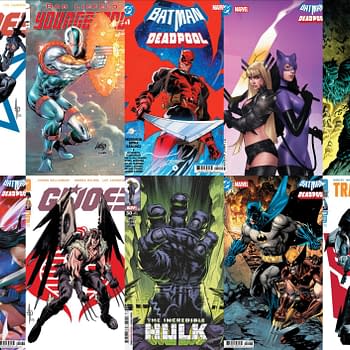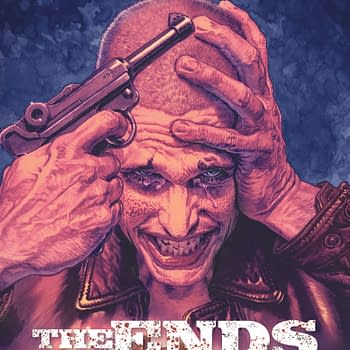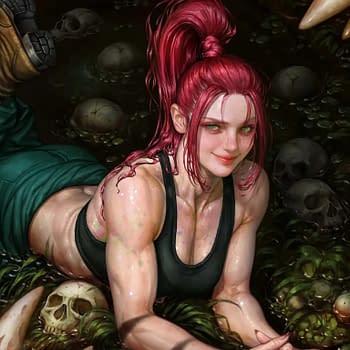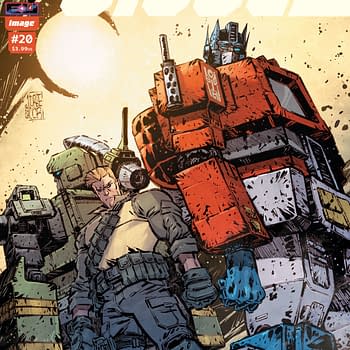Posted in: Comics, Recent Updates | Tagged: Battling Boy, Bob Fingerman, Chris Mooneyham, Comics, dark horse comics, david aja, duncan fegredo, entertainment, FirstSecond Books, five ghosts, Frank Barbiere, hawkeye, heck, Hellboy: Midnight Circus, image comics, jamie mckelvie, kieron gillen, Marvel Comics, matt fraction, Maximum Minimum Wage, mike mignola, oscar zarate, paul pope, SelfMade Hero, the gigantic beard that was evil, the park, top shelf, young avengers, zander cannon
Bleeding Cool's 11 Best Graphic Novels of 2013
By Rich Johnston and Hannah Means-Shannon
Graphic novels this year, whether stand-alone or part of an ongoing series of collections, whether collaborations or the work of a single creator, have increasingly become the experience of choice for a large body of comics readers. And then there's the appeal of gathering the collections even if you've been reading single-issues in print or digitally. Assessing the merit of a story gathered all in one place requires a different perspective, one that weighs that particular form of reader-engagement anew. Is it a page-turner? Is it a book that forces you to pause and examine detail? To what degree do you feel that you've had a unique and satisfying encounter with the medium when you close the covers, physically or metaphorically?
Rich Johnston and I put our heads together, and after some debate and haggling settled on Bleeding Cool's top 11 graphic novels of 2013. Why 11? Well, why not? As in, "up to 11" on a Marshall amplifier. We are Bleeding Cool after all.
11. Hellboy: The Midnight Circus, from Dark Horse, written by Mike Mignola, with art by Duncan Fegredo, and colors by Dave Stewart
This little book forms one complete package and is the definition of a satisfying read. It's beautifully designed and rendered, and recounts an untold tale from the legend's life taking us back to pint-sized exploits. Readers are always curious about what tot Hellboy got up to with his trademark shenanigans, but here they get more than they bargained for: a serious and humorous narrative that keeps pushing the boundaries of the Hellboy universe by drawing on a wide range of cultural traditions. It's also a dead ringer for a "coming of age" story, with interested parties beginning to interfere in Hellboy's fate, scary encounters for the naive demon spawn, and outstanding artwork by Duncan Fegredo as he shifts from the more traditional contrasty inking of Hellboy's world to painterly dream-scapes of a traveling circus with no holds barred on the strange.
10. The Park, from Selfmade Hero, written and illustrated by Oscar Zarate
Out in the UK now, out in the US soon, this counts. There are two sides to a story from two different perspectives over one event that takes place in a park. Did the dog pounce and bite, did the man flail out and kick the dog? On this everything turns and the setting of Hampstead Heath in London provides the battleground for acts of revenge. The watercoloured art reflects the weather and setting so perfectly and both notes and records the influence of the city on this patch of green within in, and how both city, and citizen, infect it, as well as a parallel love of Laurel And Hardy.
9. Battling Boy, from FirstSecond Books, written and illustrated by Paul Pope
Paul Pope is always at home in the macro-level planning of a long-form work and Battling Boy is a testament to that. Here we see that scope as well as an intrinsic commitment to visual storytelling in every panel, and an all-ages appropriate narrative to boot, bringing what is essentially the high art form of comics to the hands of younger readers. The book creates its own mythological world seamlessly, conveys it through accessible pacing and dialogue, and remains incredibly emotive from panel one to page 202. Equally versatile in action close-ups and more sublime distances in strange landscapes, it'll leave its mark on your imagination and may well be a mile-stone in hero storytelling in the comics medium.
8. The Gigantic Beard That Was Evil, from Jonathan Cape, written and illustrated by Stephen Collins
A book to make you sing with the genius of it, and a conceit that makes spot blacking swathes of heavy pencil across the page really work, and annoyingly Stephen Collins' first longform work. He has set the bar high – and the beard low. The story of a man with just one hair on his face (and not on his head) lives in a place without such follicle fancy. Until his beard emerges and dominates both his life, but the lives of those around. As a hirsute gentleman myself, I was possibly personally touched by this tale of out of control hair in a world where such a thing is unthinkable. It then grows monumental proportions, pushing him out of house and home and threatening the security of the state with its size and unruliness – and in the lesson it gives to the rest of the country, who also begin to act in an unruly fashion. It's the end of the world as they know it and the state turns to Dave (it would be Dave) as the source of the uprising. And something must be done. A book of revolution, and a beautiful story told with imagination, grace and a lot of pencil lines. And you feel the hard effort on every page. Those individual hairs don't draw themselves.
7. Maximum Minimum Wage, from Image Comics, written and illustrated by Bob Fingerman
Minimum Wage influenced a generation of indie comics creators to shake out their dirty laundry and include a street-level view of life in their work rather than sit around pondering what readers might find most appealing. What Bob Fingerman discovered, and many since, is that readers were all ears as comics became a place for visceral, recognizable experiences. Fingerman left the conclusion of the Minimum Wage series open-ended, considering a return, but before he hit that creative spot, interest by Image brought together a fully remastered collection in deluxe format as Maximum Minimum Wage. Its glorious large format shows off the artwork to even greater effect than the original series, and brings together the complete covers, a guest gallery, and commentary. It's a one-stop celebration of an era, and a must for the return of the new and ongoing Minimum Wage from Fingerman launching from Image January 8th, 2014.
6. Five Ghosts Volume 1: The Haunting of Fabian Gray, from Image Comics, written by Frank Barbiere, with art by Christopher Mooneyham, colors by Lauren Affe, and S.M. Vidaurri, logos and design by Dylan Todd
Five Ghosts was an outsider's chance book, not because of its content or art, but simply because of the degree of competition in comics to get a series pitched, launched, and noticed as creator-owned comics stormed the 2013 marketplace. The series says a lot about the interest-level and verve sustained by new comics in 2013, and for that reason, this collection of the first arc of the series stands as a poster-child for the year in comics. The trend in creating successful comics right now seems to be to simply do something no one else could possibly do in terms of strangeness and originality and hope that an audience who seeks the new and innovative will find it, and Five Ghosts hit that mark by combining literary elements from well-known traditions with edgy retro-homage artwork that speaks to the pulp ancestry of the medium. Each "chapter" of this collection packs a visual punch in terms of style and color-choices while maintaining an adventure's pacing and tight focus on character development. If there's one graphic novel collection that says, "2013", it's Five Ghosts.
5. Young Avengers Volume 1: Style > Substance, from Marvel Comics, written by Kieron Gillen, with art by Jamie McKelvie and Mike Norton, colors by Matthew Wilson, and letters by VC's Clayton Cowles
Young Avengers made waves, as a series, from its first issue, and here in one sitting you can appreciate more fully the planning and concepts behind what is a complex series that often belies its own complexity through decompressed episodic format. Because it is a comic that encourages you to "follow" the close-up dramas in individual lives, to aptly praise the mechanics behind the construction of a team-up book takes an overview approach. Here, you can spot the explication of personalities taking place around the highly-charged events of the book and get to know the characters through their interaction. But the crowning achievement here is the way in which the plot of Style > Substance becomes epic in the final two "chapters" through a gradual ramping up of events. The interconnectedness of what seem like minor plot threads, the timing of explanations about Loki's intentions make clear that reading this collection as a book does it a great deal of justice. And yes, it's decisively a single unit of narrative, too.
4. The Fifth Beatle: The Brian Epstein Story, from Dark Horse Comics, written by Vivek J. Tiwary, with pencils, inks, and colors by Andrew C. Robinson and Kyle Baker, letters by Steve Dutro
This single-volume work was a late-blooming runaway trend-setter of 2013. Those who were in the know had been waiting for it for quite some time, but to new readers it appeared meteorically generating exponentially-growing buzz, first as a New York Times Best-Seller, then as a movie property in short order. But the substance of this graphic novel goes well beyond the hype. The artwork is something unusual and highly memorable, a fusion of experiment and homage that challenges the way we traditionally represent the past in comics. Brian Epstein's life is presented in not only a warm, bright way to engage readers, but suggests a degree of sensory perception that enables the narrative to jump between points in time without losing that reader-engagement. It's a highly emotional book without telling you directly that it's a highly emotional book, and it's an intellectual book in an even more subtle way by commenting on artistic success and fame through carefully chosen phrases, not through 4th wall-breaking rhetoric. In the end, it's a volume that forms an expansive, encapsulated narrative for readers that leaves a lasting mark. And it may well spark renewed interest in bringing the history of other art-forms into the well-suited comics medium.
3. Mind MGMT Volume Two: The Futurist, from Dark Horse Comics, written and illustrated by Matt Kindt
This is an unusual situation because both Volume One: The Manager and Volume Two: The Futurist of Mind MGMT came out in 2013, and both collected significant story arcs along with extra material and a total design element governed by artist-author-designer Matt Kindt. He'd no doubt never think of the two books as competing with each other, but given the proclivity of comics journalism sites to pick "best of" lists, they essentially are vying for the same recognition. There's no doubt that Mind MGMT should be in this list, and though Kindt was committed to the single issue format, and that was part of his inspiration in creating the series in the first place, what's so special about the graphic novels? Kindt himself created them to be graphic novels out of the original series, that's what. These are some of the most satisfying books on the market for intricate detail that's almost maddeningly good, tiny messages in the margins, excerpts of running fictional narratives, side-stories placed where he sees them to fit best, and they're nearly an inch thick of in-depth reading too. But why Volume Two? I wouldn't venture to say that this was beyond Kindt's planning, but the series, and therefore the graphic novels, actually increase in pace, volume, and intensity as they go. Volume Two gets to side-step the set up elements necessary in Volume One and dive further into the mind-bending revelations about the Agency, jumps into more disorienting zones in the psychology of "the Futurist" himself, and sees Meru confronting all the knowledge she's previously been denied. If Volume Two hadn't come out in 2103, Volume One would be in this slot, but Kindt one-upped himself and that sort of paradox just shouldn't exist. It's a mystery as big as Mind MGMT. He should shake hands with himself in the spirit of good sportsmanship. The scary thing is, this could well happen again in 2014.
2. Heck, from Top Shelf Productions, written and illustrated by Zander Cannon
Heck started off as a 144-hour graphic novel project for writer and illustrator Zander Cannon and once he'd started it, he just couldn't let it go. That's the experience for the reader, too. If a litmus test of a strong graphic novel is how painful it is to stop reading it once you've started, this takes top marks. It re-imagines some of the biggest motifs in the spiritual and literary traditions of western thought: a descent into hell, a ruthless self-examination of one's own relationships and motives in do-gooding, an an interrogation, in short, of all the things we seem to inherit as sage wisdom in our culture. And boy do those scales find answers wanting. Heck is unafraid of posing the big questions, and the artwork simplicity and gravity will remain etched in your memory as firmly as a Bergman film. It's the little things that are only partly explained that stay with you, the certainty that human beings are far worse than they think they are, and maybe even a smidgeon better too, that will wreak havoc on your certainties. Did I say it's a fun book too? As hard as that is to reconcile, Heck is energetic, curious, defiant, and at times darkly humorous. It will be a long, long while before such an independently crafted book manages to combine such extremes of human thought and frustration and still achieves a thoroughly engaging adventure format along the way. And if another one comes along, it'll probably be by Zander Cannon.
1. Hawkeye Volume 1: My Life as a Weapon, from Marvel Comics, written by Matt Fraction, with art by David Aja and Javier Pulido
Well, who are we to argue with the Angouleme Official Committee? While it is arguable that the book reaches its heights of creativity with later issues, that's to belie the remarkable sea change and success fits earlier issues, in completely and utterly breaking the expectation of what one can do with a superhero comic book starring a very familiar Avenger. Already having an influence on its kin, this is the All Star Superman, The Authority, the Kick Ass of 2013, something that breaks all the rules, pushes for something seemingly uncommercial and then receives the laudits and the success it deserves. The "superhero on his day off" story has been told so many times, Hawkeye both convinces that yes, this is exactly what Hawkguy would get up to, finds ways to make the microcosm far more fascinating and dangerous as anything Infinity gave us, preserves grace and good humor, utterly entrenches characters such as Kate Bishop and Pizza Dog, and then breaks the rules of what a comic should be, how panel to panel storytelling can work and has more in common with experimental storytelling than it has a right to – and then dominates bookstore sales for Marvel. What Saga did, Hawkeye did too. We don't deserve it, we really don't.
Honorable mentions to… The Hartlepool Monkey, Verity Fair, The Chew Smorgasbord, Star Wars: Jedi Academy, Nemo: Heart Of Ice, March, Regis Loisel's Peter Pan, Lighter Than My Shadow, Ilya's Room For Love.


























